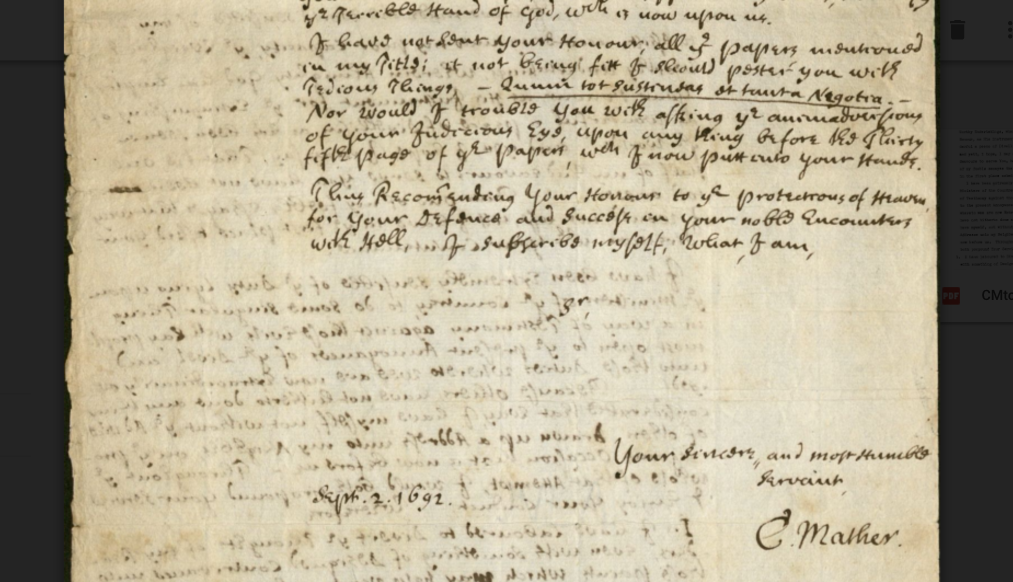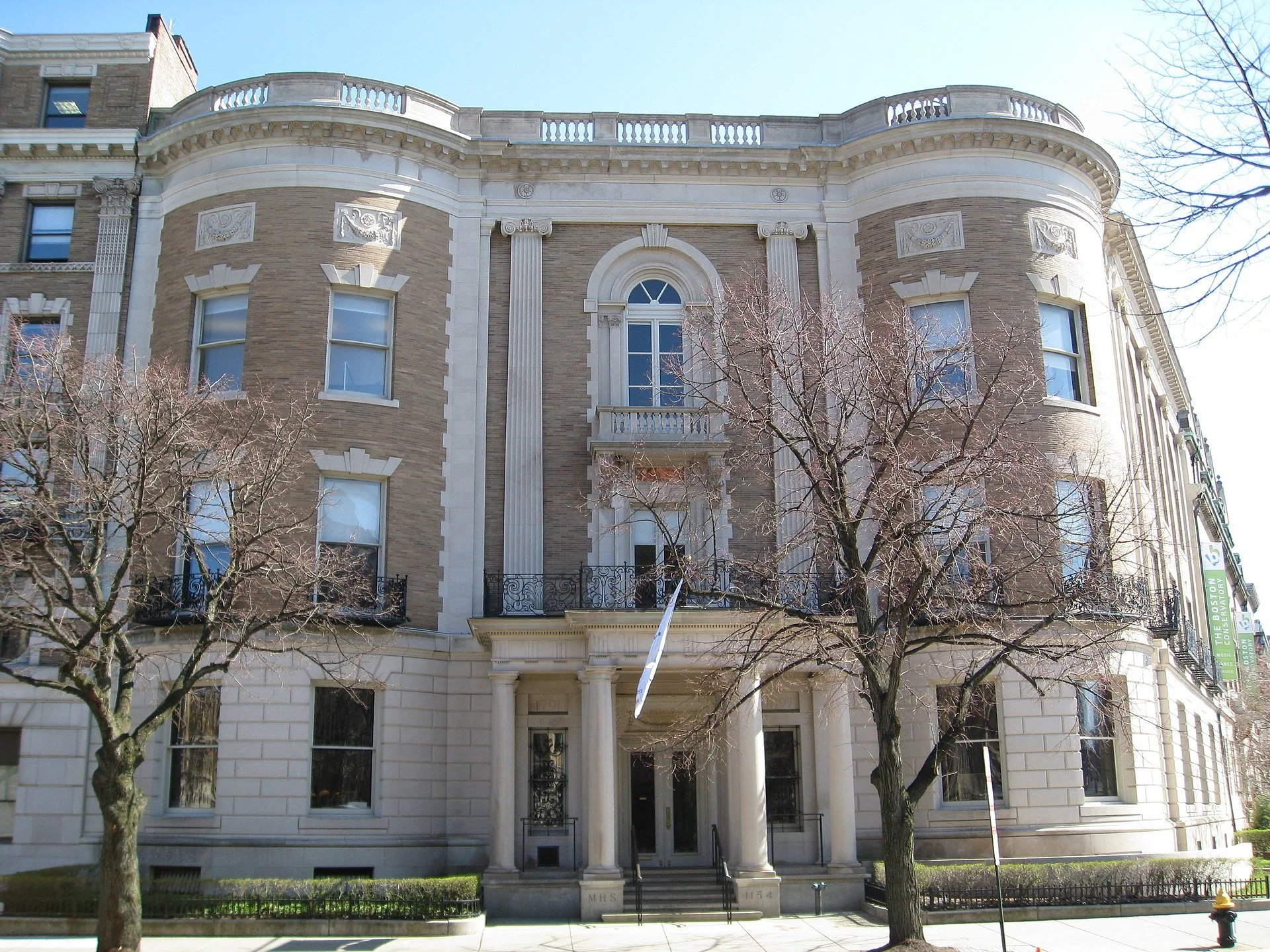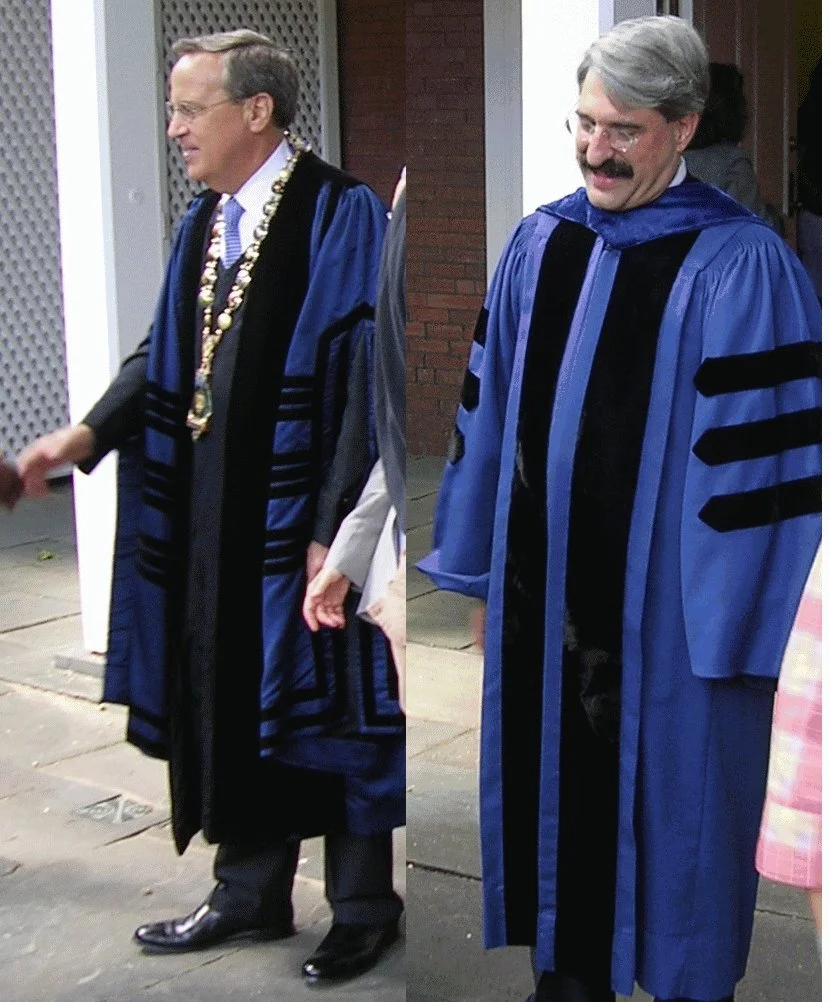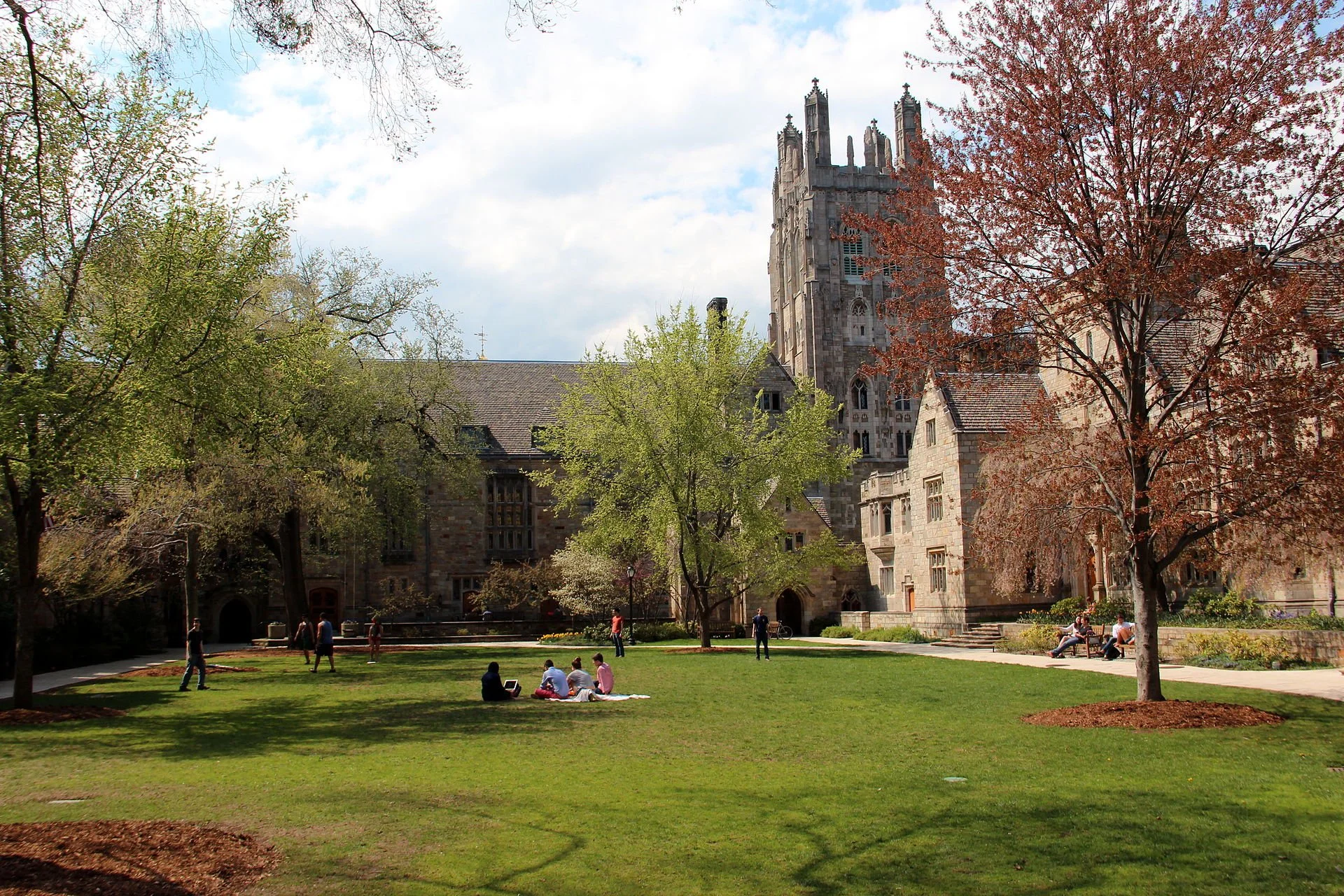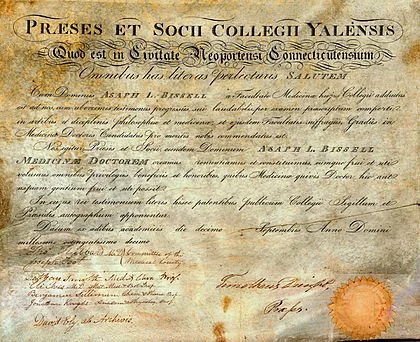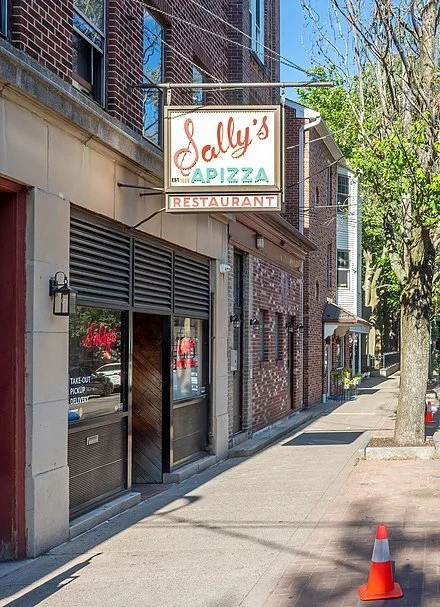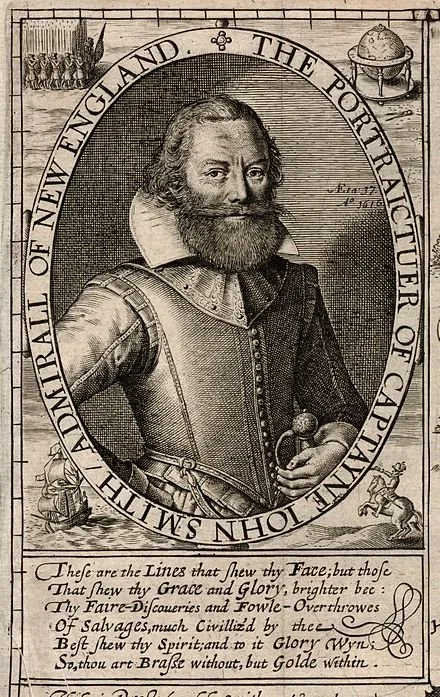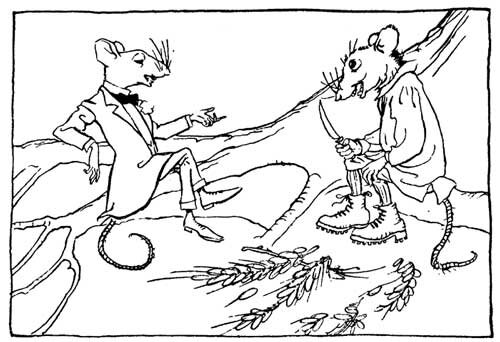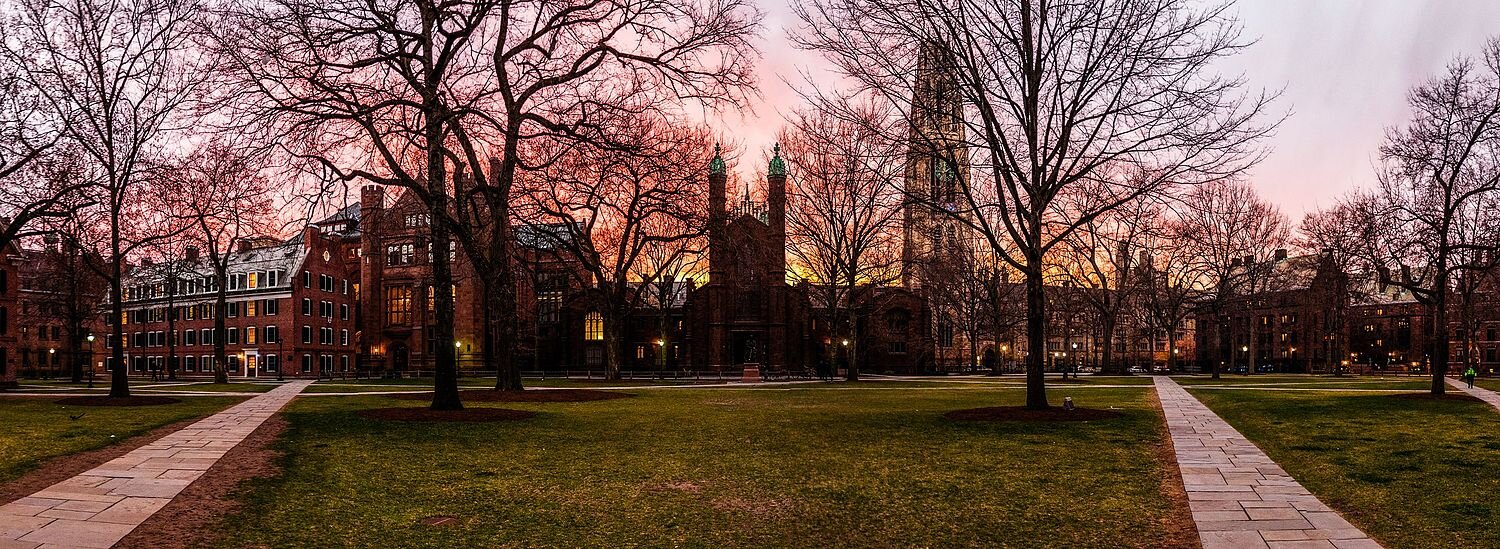
Chris Powell: What do college demonstrators in Conn. and elsewhere mean by ‘Free Palestine’?
Pro-Palestinian demonstration by students near Harvard University, in Cambridge, Mass.
MANCHESTER, Conn.
College is back in session and students are returning not just to their studies but also to protests on campus about the war in Gaza. At the University of Connecticut at Storrs, Yale University in New Haven, and other institutions, students are chanting and carrying signs reading "Free Palestine!"
Journalism not being what it used to be, since literacy and civic engagement aren't either, no one seems to be asking the students exactly what they mean by "Free Palestine!" and how that objective should be achieved.
So how do the student protesters define Palestine? Do they define it as most Palestinians themselves do, as encompassing the land "from the river to the sea" -- the land between the Jordan River and Mediterranean -- thus liquidating Israel, as Palestinians often have tried to do in war since the area was partitioned into Jewish and Arab sections by resolution of the United Nations in 1948, and as they are doing again now?
Do the student protesters define Palestine as something that leaves room for Israel -- a Palestine consisting of Gaza, which Israel evacuated in 2005, and the "occupied West Bank," the land between Jordan and Israel proper, most of which Israel agreed to evacuate during negotiations sponsored by President Bill Clinton in 2000?
If the student protesters define Palestine as the Clinton plan did, they might want to ask the people on whose behalf they're protesting why they can't accept such a compromise even now that the war that Gaza launched against Israel last October has brought catastrophic bloodshed and ruin to the territory. The students should explain why Palestinian irredentism is worth so much.
And what do the student protesters mean by "free"? Do they mean civil liberties -- speech, press, assembly, religion, due process of law, women's rights, and sexual orientation -- liberties enjoyed in the United States, Western Europe, and Israel, but not in Gaza and West Bank areas under Palestinian control, nor, indeed, anywhere in the Arab world? If that's what the student protesters mean, they should go to Gaza or the West Bank and try to exercise such freedoms there, after making provision for the transport home of their corpses.
Or do the student protesters understand "free Palestine" as most Palestinians appear to understand it -- a land free of Jews, a land free to attack a neighboring state and people, bombarding, murdering, raping, and kidnapping whenever the necessary strength has been regained during another "ceasefire"?
Yes, the war in Gaza is horrifying. But then wars against totalitarians seldom can be won politely. The war against the totalitarian aggressors of World War II, Germany and Japan, were won only by leveling both countries, killing millions of civilians, and then remaking the totalitarian societies through long military occupations.
If the student protesters think there is another way, they should spell it out and offer it to the warring parties. They may find, as Clinton did, that making peace requires more than pious hand-wringing on a peaceful campus far away from cutthroats whose hatred and brutality far surpass anything the students can imagine.
TREATMENT ISN'T ENOUGH: School officials and social workers report that Connecticut is facing an epidemic of mental illness among young people -- not just teens in high school but also children in elementary and middle school. There is clamor for state government to spend more for treatment and school mental-health clinics, as if that will solve the problem.
Little attention is being paid to the cause of the youth mental-illness epidemic. The recent virus epidemic and its disruption of school and home life is an easy explanation, but that epidemic is long over. Something else must be wrong. Child neglect was already bad when the virus struck. Because inflation soared during much of the time since the epidemic started, real incomes for many have fallen. That may have worsened neglect.
Treatment isn't enough. The General Assembly and Gov. Ned Lamont should strive to discern and eradicate the causes of youth mental illness.
Chris Powell has written about Connecticut government and politics for many years (CPowell@cox.net).
A place for safe ‘ruthless examination’
“Universities should be safe havens where ruthless examination of realities will not be distorted by the aim to please or inhibited by the risk of displeasure.’’
— Kingman Brewster (1919-1988), president of Yale University, 1963-1977) and U.S. ambassador to the United Kingdom, 1977-1981. He was thought to have inspired Garry Trudeau's fictional character President King in the comic strip Doonesbury.
Dukes of documentation
Letter from The Rev. Cotton Mather (1663-1728) to Massachusetts Judge William Stoughton (1631-1701), dated Sept. 2, 1692
— Photo by Lewismr
Massachusetts Historical Society headquarters, Boston. It houses a treasure trove of historical New England documents
— Photo by Biruitorul
“The men who founded and governed Massachusetts and Connecticut took themselves so seriously that they kept track of everything they did for the benefit of posterity and hoarded their papers so carefully that the whole history of the United States, recounted mainly by their descendants, has often appeared to be the history of New England writ large.”
— Edmund Morgan (1916-2013), Yale history professor
Very old-fashioned
Adapted from Robert Whitcomb’s “Digital Diary,’’ in GoLocal24.com
We attended part of Yale University’s commencement on May 22, at the School of Music, where a young friend of ours was getting a doctorate. We were struck again by how these ceremonies are some of the few remaining events connecting us to Medieval and Renaissance times – the robes draped with various university’s colors, the floppy velvet caps, the smattering of Latin, not to mention Yale’s famous Gothic Collegiate architecture, constructed with early 20th Century industrial/robber baron money and made to look very old – recalling Oxford and Cambridge and befitting an institution aimed at nurturing America’s Anglophilic ruling class.
But some of the degree recipients’ sandals and tattoos were reminders of where we are now.
Commencement speakers, both officials from the university or college itself as well as speakers from outside, affect an old-fashioned earnestness, if seasoned with successful or failed stabs at mild humor. Irony is heavily rationed at these things. It conveys a kind of theatrical innocence.
All students admitted to the Yale Music School go tuition-free, with the exception of those who have earned equivalent funding from other sources, thanks to a gift from an alumnus mogul called Stephen Adams. The marriage of big money and art. The Medicis, the leading bankers and art patrons of Renaissance Florence, would have approved.
Chris Powell: Feds should bar defense contractors from extorting corporate welfare from states; fascism and theft at Yale
A Sikorsky Black Hawk helicopter
MANCHESTER, Conn.
Connecticut may be paying the Sikorsky helicopter division of military contractor Lockheed Martin as much as $250 million to keep its facilities in the state for the next 20 years -- an average of more than $12 million per year -- if the company gets major new helicopter contracts from the U.S. Defense Department.
Gov. Ned Lamont has struck such a deal with Sikorsky, similar to one struck by his predecessor, Dannel P. Malloy. While the General Assembly would have to approve it, legislative leaders of both parties seem to favor it because Sikorsky, based in Stratford, already has about 8,000 employees and 250 suppliers in the state and with the new contracts might hire thousands more.
Even with the subsidy from state government, Sikorsky could relocate to a state that made a better offer, though it might have to repay whatever it had taken from Connecticut.
Under the circumstances the subsidy may be good policy. But it is still corporate welfare, and smiling through it are Connecticut's members of Congress. Instead they should be advocating legislation to prevent recurrence of this kind of thing not just in Connecticut but throughout the country.
States should compete with each other to draw businesses and residents. But the federal government shouldn't take sides in this competition. The federal government should prevent military contracts from being used as leverage to extort corporate welfare from state and municipal governments.
That is, federal law could forbid military contractors from obtaining corporate welfare that is conditioned on the award of a military contract, like the corporate welfare that Connecticut plans to give Sikorsky.
With the Sikorsky arrangement, the leverage of the federal government will be used not for public gain but for corporate gain. What President Eisenhower called the military-industrial complex has enough power, influence and wealth already.
xxx
Yale University, in New Haven, is as renowned as any institution of higher education in the world. But recent events suggest that Yale is overrated.
In recent years Yale has become a center of political correctness as much as education, and on March 10 this political correctness turned again to fascism as more than a hundred students at the university's law school besieged what was supposed to be a forum on civil liberties.
The students interrupted the forum, stood up and held signs, blocking sight lines, and shouted and jeered in objection to the participation of one of the invited speakers, a representative from the Alliance Defending Freedom, which supports the civil liberties of conservatives. Police were needed to escort the speakers away.
While the young fascists are law students, Yale will not punish them, apparently because they noisily left the assembly room and congregated disruptively outside before they were given a fourth warning, a threshold set in student conduct rules.
Neither will Yale give any thought to how such people are getting admitted to the university, nor to why the atmosphere at the university is so intolerant of political disagreement.
Then last week, Jamie Petrone, a former finance official in Yale's School of Medicine pleaded guilty to federal charges that she stole $40 million in electronics equipment from the university over 10 years through the fraudulent purchase and sale of computer equipment and programming.
Yale also has a School of Management, but the student thuggery and colossal theft at the university suggest that it doesn't have nearly enough management.
xxx
Legislation to allow farmers to get state permits to shoot bears and other predatory animals that damage crops and kill or injure livestock failed last week in the General Assembly's Environment Committee on a vote of 18-13.
Connecticut already allows deer hunting to protect agriculture and deer don't attack livestock as bears do, so it is hard to understand the opposition to protecting agriculture against bears.
The bill that was rejected did not authorize a general bear-hunting season in Connecticut. But unless bear hunting is authorized soon to some extent, the continuing explosion in the bear population will put at least several bears in every town. Their cuteness is already wearing off fast.
Chris Powell is a columnist for the Journal Inquirer, in Manchester.
Yale medical diploma awarded Asaph Leavitt Bissell, Class of 1815, signed by school's four professors and Yale President Timothy Dwight IV.
Tools of off-and-on abstraction
“Bone Music #1” (1949) (pen, ink and watercolor), by Dorothy Dehner (1901-1994), at the Yale University Art Gallery, in its group show “Midcentury Abstraction: A Closer Look,’’ Feb. 25-June 26.
The gallery says:
"Eschewing the notion that there was a linear shift toward abstraction at midcentury, the exhibition showcases a group of artists who freely moved in and out of abstraction or blended their radical approaches with traditional subject matter, such as landscape, portraiture, or still life."
Loco in loco
Storefront on Wooster Street in New Haven. New Haven is well known for its pizza but Yale students have been ordered not to eat in the city’s restaurants at least until Feb. 7 in an example of stringent medical theater.
Adapted from Robert Whitcomb’s “Digital Diary,’’ in GoLocal24.com
This note from a Connecticut boarding school is a display of that fragmenting thing, for a multiethnic semi-democracy, of excessive identity politics:
“As we continue the important dialogue
among Taft's BIPOC {Black and Indigenous People of Color} alumni and students,
we hope you will join us virtually
Thursday, January 13, 7pm EST
This event includes
Taft's Pan-Asian Affinity Group,
Mosaics (Black/LatinX Female Affinity Group),
Shades (Black/LatinX Male Affinity Group),
and Somos (LatX Affinity Group)’’
Education should be almost entirely focused on people as individuals, not as members of groups.
In other academic craziness, Yale has told students, whom they have placed under a quarantine until Feb. 7, that they:
“{M}ay not visit New Haven businesses or eat at local restaurants (even outdoors) except for curbside pickup.”
Does the university plan to send the campus cops around the city to arrest resisters at their tables?\
Then we have Princeton University’s order:
“Beginning January 8 through mid-February, all undergraduate students who have returned to campus will not be permitted to travel outside of Mercer County or Plainsboro Township for personal reasons, except in extraordinary circumstances. … We’ll revisit and, if possible, revise this travel restriction by February 15.”
Will there be roadblocks at the county line?
This is ridiculous medical theater and lunatic in loco parentis that will have little or no effect on the spread of COVID, which is pretty much everywhere now anyway.
But it’s certainly a good way to create right-wingers.
Why New England has a certain coherence and consistency
The flag of the New England Governors Conference. The pine symbol has been associated with the region from early Colonial days. The wood was used for housing, boats and furniture. The nickname of the region’s most wooded state, Maine, is The Pine Tree State.
But the origin of the several similar New England flags also goes back to the Red Ensign of the Royal Navy, first used in 1625, with merchant vessels being granted its use by 1663. Shipping became a major part of the region’s economy early on.
“New England, unlike the rest of the United States and other parts of the world that were colonized by European powers, is a realized idea. The people who, from a European perspective, were its founders had envisioned that New England would continue a tradition in Christian history, and also political history, by becoming a plantation for Christianity in the “new world,” which would function as an autonomous republic.
New England was created by colonists who fanned out from that initial Massachusetts Bay colony. The colonists who were granted the charter for Massachusetts Bay were given small tracts of land. They created new colonies that were pulled together through the forces of economics and culture. So, the vision that shaped the beginnings of Massachusetts was stamped on the region as a whole. New England developed a consistency and coherence that much of the rest of the United States lacks.’’
—- Mark Peterson, a professor of history at Yale University, in an interview with Five Books
English explorer and soldier John Smith coined the name “New England’’ in 1616.
Chris Powell: Car thefts are the least of it in juvenile-justice scandal; Yale saves New Haven
Ford Explorer with broken window after it was stolen
MANCHESTER, Conn.
Democrats in Connecticut insist that there is no crime wave in the state and that concerns about crime are Republican contrivances. But it's nice that the state's minority party is pressing any issues at all, and Connecticut lately has had some criminal atrocities that really should be learned from, especially some involving juveniles.
One of those atrocities unfolded last week in Manchester, when a 14-year-old boy was charged with the rape and murder of a 13-year-old girl last June. News reports about the arrest discovered that state law prohibits the boy from being tried in open court and, if he is convicted, will prohibit him from being sentenced to anything more severe than 2½ years of probation, regardless of whether he is a predatory maniac or a great kid who made what the social workers may get away with calling a "mistake."
Whatever the boy is, the secrecy of court for murder defendants under 15 years old will prevent the public from ever finding out.
Few teenagers read newspapers or pay attention to broadcast news, but they do talk to each other and so news can spread among them all the same. Thanks to the Manchester case they now may perceive that in Connecticut they are pretty much free to rape and murder until they turn 15, and they may perceive that their exemption from criminal responsibility for car thefts, which they already well understand and that recently has become controversial, is actually the least of the scandal of juvenile justice here.
A spokeswoman for the social work school of thought, Illiana Pujols, of the Connecticut Justice Alliance, says the state's adult-justice system isn't made to serve children. But in its glorious secrecy, unaccountability and exemption of young offenders from responsibility even for atrocities, is the state's juvenile-justice system made to serve the public?
xxx
Yale University, whose ownership of so much property in New Haven takes much of it off the city's property-tax rolls, has a new six-year deal with the city. The university will increase its annual voluntary payment to the city from the current $13.2 million to $23 million, leading to total payments of more than $135 million by the arrangement's conclusion.
That kind of money could cover much of the city's underfunding of its pension programs and pay lots of raises, though whether it does much for the city itself must remain to be seen.
Mayor Justin Elicker and City Council members are thrilled by the deal, since the university, as a nonprofit corporation, isn't legally required to pay taxes on its noncommercial property. But the deal really isn't so generous.
For Yale already was suffering an embarrassment of riches, heightened by the recent stock market boom, which has boosted the university's endowment to $42 billion. The endowment has been managed extraordinarily well, so well that the joke is that Yale is actually a hedge fund disguised as a university. Yale is so wealthy that, as National Review noted the other day, it can afford to have more employees (nearly 17,000) than students (about 12,000).
But then the university's work is not just to teach but to be constantly striking politically correct poses to appease the political left that dominates it. Those poses now will be facilitated by a new city undertaking called the Center for Inclusive Growth, to which Yale will contribute $5 million over the next six years. The center may provide patronage jobs for growing still more political correctness in New Haven.
xxx
U.S. Education Secretary Miguel Cardona, briefly Connecticut's education commissioner, boasted last week of another big round of student0loan forgiveness -- $2 billion for 33,000 borrowers -- through the Public Service Loan Forgiveness program, for which teachers and employees of nonprofits are eligible.
Some of the debtors are indeed hard-pressed but as with most student-loan debt the borrowers are not the biggest beneficiaries of loan forgiveness. Student-loan debt becomes burdensome when the education for which the debt was incurred cannot qualify the borrower for a job that pays enough both to support him and repay the debt.
That is, the real beneficiaries of student loans are employees of higher education, which is overvalued and yet made still more expensive by those loans.
Chris Powell is a columnist for the Journal Inquirer, in Manchester.
Don Pesci: The City Mouse fatalistically faces the spreading stupidity pandemic
1912 Drawing derived from the Aesop’s Fables tale “The Town Mouse and The Country Mouse,’’ by Arthur Rackham
VERNON, Conn.
The merry month of May has burst upon Connecticut. The City Mouse went to lunch in Hartford with one of her lady friends – sans mask, while they were eating – and a conversation arose concerning the age-old quarrel between city and country.
The City Mouse is a no-nonsense character, a quality disappearing quickly in our homogenously progressive Connecticut culture -- Connecticulture? -- and differences of opinion clouded the air.
The City Mouse was not surprised that Yale law students had launched a lawsuit against a wealthy suburb because, the students asserted, Woodbridge had, through its zoning regulations, frustrated the construction of low-rent housing in what had been historically a predominantly middle-class municipality. If the suit were to be decided in favor of the Yale students, a certain percentage of low-income housing would be required in all Connecticut municipalities, not solely in Woodbridge.
“Law students will be law students,” the City Mouse said, “but the zoning regulations in Woodbridge are not racist. They regulate lot size, which has attracted middle-class homeowners to Woodbridge. How many Yale students finding employment opportunities in Connecticut’s Gold Coast, or in an increasingly impoverished New York City, have over the past few decades settled in Woodbridge rather than, say New Haven? How many of New York's tax-tortured residents have moved to New Haven rather than Woodbridge or other Connecticut Gold Coast communities? The students’ attack upon zoning regulations in Woodbridge is what it appears to be on its face – an assault upon representative municipal governance first by the courts and, at some point in the near future, by a compliant progressive legislature.”
Their server, Brian, approached to refill their wine glasses. He was a young man – well educated, both could see – who was working his way through college. He had been at a Connecticut university for a couple of years, gliding through on a partial scholarship, and both had talked with him at length before.
“Brian,” Lady Friend said, “your restaurant appears to be reviving now that Coronavirus restrictions have been lifted. Good for you, right?”
“Yes. There’s plenty of work. But a different problem has cropped up.”
“Ah,” Lady Friend asked, “What is it?”
This question caused some unease. Brian, suitably masked, looked cautiously over his shoulder, then ventured in a whisper, “The restaurant is having a problem securing help.”
“From state and federal government, you mean?”
“No, everyone there wants to undo the harm they’ve done through shutdown regulations. Help… you know, servers, dishwashers and the like.”
Looking conspiratorially over her shoulder, The Country Mouse said, “Well, no slur intended on you, Brian, but you don’t need a Harvard education to serve food and wash dishes. And there is a huge untapped, unemployed population in Hartford that has not graduated from Yale or Harvard law schools and may be tapped to work in restaurants -- so, what’s the problem?”
“They have other means.”
“I don’t understand,” said Lady Friend.
And here, the City Mouse broke in. “Brian is suggesting that welfare payments and superior benefits keep the unemployed on the public payroll.”
“Is that it?” Lady friend asked, a note of quiet desperation in her voice.
“That’s it,” Brian said, and sped off to another table.
“I can’t imagine,” the City Mouse said, with a sardonic trill in her voice, “what the solution to that problem might be, apart from bringing restaurants onto the public dole. State support of restaurants could be sold on the supposition that restaurants might be better managed by legislators rather than restaurant owners. But you and I know -- don’t we? -- that it would drive up the cost of everything. Just look at the spikes over the past five decades in welfare costs, state employee salaries and pensions and so called ‘fixed costs,’ which cannot legislatively be unfixed without unseating certain legislators.”
“Imagine that,” said Lady Friend, “you solve one problem, and another knocks you on the head.”
“Like sowing dragon’s teeth,” the City Mouse mused.
The problem has been solved, I reported to The City Mouse. On May 3, the Hartford City Council proposed an equitable solution: “City exploring universal basic income.”
The lede to the story in a Hartford paper ran as follows: “The city of Hartford is considering experimenting with a universal basic income [UBI], starting with designing a pilot program that would give no-strings-attached monthly payments to participating city residents.”
The program would “target single, working parents, with a goal of learning whether extra, guaranteed income improves recipients’ physical and emotional well-being, job prospects and financial security.”
The lessons apparently already have been learned by the City Council.
The story bulges with approving quotes from a University of Connecticut economist, the council president, various council members, all Democrats, and a solitary Working Families Party member. Those outside Connecticut should know that the state’s Working Party lives in the basement of the state’s progressive Democrat Party.
A 2018 study of a similar UBI program in Alaska, the paper reported, found that “it did not increase unemployment as some critics feared and had actually increased part-time work.”
“So, no need to worry anymore,” I teased The City Mouse.
Her response, delivered with a painful sigh: “If only stupidity were as easy to dispose of as Coronavirus.”
Don Pesci is a Vernon-based columnist.
Before sliding down the razor blade
Tom Lehrer in 1957, as he was becoming famous.
Bright college days, oh, carefree days that fly
To thee we sing with our glasses raised on high.
Let's drink a toast as each of us recalls
Ivy-covered professors in ivy-covered halls.
Turn on the spigot
Pour the beer and swig it
And gaudeamus igitur
Here's to parties we tossed
To the games that we lost
We shall claim that we won them some day.
To the girls young and sweet
To the spacious back seat
Of our roommate's beat up Chevrolet.
To the beer and benzedrine
To the way that the dean
Tried so hard to be pals with us all.
To excuses we fibbed
To the papers we cribbed
From the genius who lived down the hall.
To the tables down at Mory's
Wherever that may be
Let us drink a toast to all we love the best.
We will sleep through all the lectures
And the cheat on the exams
And we'll pass, and be forgotten with the rest.
Oh, soon we'll be out amid the cold world's strife.
Soon we'll be sliding down the razor blade of life
O-oh!
But as we go our sordid separate ways
We shall ne'er forget thee, thou golden college days.
Hearts full of youth.
Hearts full of truth.
Six parts gin to one part vermouth.
“Bright College Days,’’ by Tom Lehrer (born 1928), a now retired American musician, singer-songwriter, satirist, mathematician and professor (in which position he taught mathematics and the history of musical theater, among other topics). He’s best known for the often hilarious and sometimes biting songs that he recorded in the 1950s and 1960s, though he had written some of the songs as early as the late ‘40s. A Harvard graduate, he taught there as well as at MIT, Wellesley College and the University of California at Santa Cruz. In his heyday, he starred in numerous concerts, singing his songs as he played them on a piano.
Mory’s, founded in 1849, is a private club/restaurant/watering hole in New Haven whose membership is confined to those with Yale connections. It is virtually on the Yale campus.
Liz Szabo: Some COVID-19 patients hit by friendly fire
The Warren Alpert Medical School at Brown University, in Providence’s old “Jewelry District.’’ Most people still just call it the Brown Medical School.
Dr. Megan Ranney, of Brown University, has learned a lot about COVID-19 since she began treating patients with the disease in the emergency department in February.
But there’s one question that she still can’t answer: What makes some patients so much sicker than others?
Advancing age and underlying medical problems explain only part of the phenomenon, said Ranney, who has seen patients of similar age, background and health status follow wildly different trajectories.
“Why does one 40-year-old get really sick and another one not even need to be admitted?” asked Ranney, an associate professor of emergency medicine at Brown.
In some cases, provocative new research shows, some people — men in particular — succumb because their immune systems are hit by friendly fire. Researchers hope the finding will help them develop targeted therapies for these patients.
In an international study in Science, 10 percent of nearly 1,000 COVID patients who developed life-threatening pneumonia had antibodies that disable key immune system proteins called interferons. These antibodies — known as autoantibodies because they attack the body itself — were not found at all in 663 people with mild or asymptomatic COVID infections. Only four of 1,227 healthy individuals had the autoantibodies. The study, published on Oct. 23, was led by the COVID Human Genetic Effort, which includes 200 research centers in 40 countries.
“This is one of the most important things we’ve learned about the immune system since the start of the pandemic,” said Dr. Eric Topol, executive vice president for research at Scripps Research, in San Diego, who was not involved in the new study. “This is a breakthrough finding.”
In a second Science study by the same team, authors found that an additional 3.5 percent of critically ill patients had mutations in genes that control the interferons involved in fighting viruses. Given that the body has 500 to 600 of these genes, it’s possible researchers will find more mutations, said Qian Zhang, lead author of the second study.
Interferons serve as the body’s first line of defense against infection, sounding the alarm and activating an army of virus-fighting genes, said virologist Angela Rasmussen, an associate research scientist at the Center of Infection and Immunity at Columbia University’s Mailman School of Public Health.
“Interferons are like a fire alarm and a sprinkler system all in one,” said Rasmussen, who wasn’t involved in the new studies.
Lab studies show interferons are suppressed in some people with COVID-19, perhaps by the virus itself.
Interferons are particularly important for protecting the body against new viruses, such as the coronavirus, which the body has never encountered, said Zhang, a researcher at Rockefeller University’s St. Giles Laboratory of Human Genetics of Infectious Diseases.
When infected with the novel coronavirus, “your body should have alarms ringing everywhere,” said Zhang. “If you don’t get the alarm out, you could have viruses everywhere in large numbers.”
Significantly, patients didn’t make autoantibodies in response to the virus. Instead, they appeared to have had them before the pandemic even began, said Paul Bastard, the antibody study’s lead author, also a researcher at Rockefeller University.
For reasons that researchers don’t understand, the autoantibodies never caused a problem until patients were infected with COVID-19, Bastard said. Somehow, the novel coronavirus, or the immune response it triggered, appears to have set them in motion.
“Before COVID, their condition was silent,” Bastard said. “Most of them hadn’t gotten sick before.”
Bastard said he now wonders whether autoantibodies against interferon also increase the risk from other viruses, such as influenza. Among patients in his study, “some of them had gotten flu in the past, and we’re looking to see if the autoantibodies could have had an effect on flu.”
Scientists have long known that viruses and the immune system compete in a sort of arms race, with viruses evolving ways to evade the immune system and even suppress its response, said Sabra Klein, a professor of molecular microbiology and immunology at the Johns Hopkins Bloomberg School of Public Health.
Antibodies are usually the heroes of the immune system, defending the body against viruses and other threats. But sometimes, in a phenomenon known as autoimmune disease, the immune system appears confused and creates autoantibodies. This occurs in diseases such as rheumatoid arthritis, when antibodies attack the joints, and Type 1 diabetes, in which the immune system attacks insulin-producing cells in the pancreas.
Although doctors don’t know the exact causes of autoimmune disease, they’ve observed that the conditions often occur after a viral infection. Autoimmune diseases are more common as people age.
In yet another unexpected finding, 94 percent of patients in the study with these autoantibodies were men. About 12.5 percent of men with life-threatening COVID pneumonia had autoantibodies against interferon, compared with 2.6 percent of women.
That was unexpected, given that autoimmune disease is far more common in women, Klein said.
“I’ve been studying sex differences in viral infections for 22 years, and I don’t think anybody who studies autoantibodies thought this would be a risk factor for COVID-19,” Klein said.
The study might help explain why men are more likely than women to become critically ill with COVID-19 and die, Klein said.
“You see significantly more men dying in their 30s, not just in their 80s,” she said.
Akiko Iwasaki, a professor of immunobiology at the Yale School of Medicine, noted that several genes involved in the immune system’s response to viruses are on the X chromosome.
Women have two copies of this chromosome — along with two copies of each gene. That gives women a backup in case one copy of a gene becomes defective, Iwasaki said.
Men, however, have only one copy of the X chromosome. So if there is a defect or harmful gene on the X chromosome, they have no other copy of that gene to correct the problem, Iwasaki said.
Bastard noted that one woman in the study who developed autoantibodies has a rare genetic condition in which she has only one X chromosome.
Scientists have struggled to explain why men have a higher risk of hospitalization and death from COVID-19. When the disease first appeared in China, experts speculated that men suffered more from the virus because they are much more likely to smoke than Chinese women.
Researchers quickly noticed that men in Spain were also more likely to die of COVID-19, however, even though men and women there smoke at about the same rate, Klein said.
Experts have hypothesized that men might be put at higher risk by being less likely to wear masks in public than women and more likely to delay seeking medical care, Klein said.
But behavioral differences between men and women provide only part of the answer. Scientists say it’s possible that the hormone estrogen may somehow protect women, while testosterone may put men at greater risk. Interestingly, recent studies have found that obesity poses a much greater risk to men with COVID-19 than to women, Klein said.
Yet women have their own form of suffering from COVID-19.
Studies show women are four times more likely to experience long-term COVID symptoms, lasting weeks or months, including fatigue, weakness and a kind of mental confusion known as “brain fog,” Klein noted.
As women, “maybe we survive it and are less likely to die, but then we have all these long-term complications,” she said.
After reading the studies, Klein said, she would like to learn whether patients who become severely ill from other viruses, such as influenza, also harbor genes or antibodies that disable interferon.
“There’s no evidence for this in flu,” Klein said. “But we haven’t looked. Through COVID-19, we may have uncovered a very novel mechanism of disease, which we could find is present in a number of diseases.”
To be sure, scientists say that the new study solves only part of the mystery of why patient outcomes can vary so greatly.
Researchers say it’s possible that some patients are protected by past exposure to other coronaviruses. Patients who get very sick also may have inhaled higher doses of the virus, such as from repeated exposure to infected co-workers.
Although doctors have looked for links between disease outcomes and blood type, studies have produced conflicting results.
Screening patients for autoantibodies against interferons could help predict which patients are more likely to become very sick, said Bastard, who is also affiliated with the Necker Hospital for Sick Children, in Paris. Testing takes about two days. Hospitals in Paris can now screen patients on request from a doctor, he said.
Although only 10 percent of patients with life-threatening COVID-19 have autoantibodies, “I think we should give the test to everyone who is admitted,” Bastard said. Otherwise, “we wouldn’t know who is at risk for a severe form of the disease.”
Bastard said he hopes his findings will lead to new therapies that save lives. He notes that the body manufactures many types of interferons. Giving these patients a different type of interferon — one not disabled by their genes or autoantibodies — might help them fight off the virus.
In fact, a pilot study of 98 patients published Thursday in the Lancet Respiratory Medicine journal found benefits from an inhaled form of interferon. In the industry-funded British study, hospitalized COVID patients randomly assigned to receive interferon beta-1a were more than twice as likely as others to recover enough to resume their regular activities.
Researchers need to confirm these findings in a much larger study, said Dr. Nathan Peiffer-Smadja, a researcher at Imperial College London who was not involved in the study but wrote an accompanying editorial. Future studies should test patients’ blood for genetic mutations and autoantibodies against interferon, to see if they respond differently than others.
Peiffer-Smadja notes that inhaled interferon may work better than an injected form of the drug because it’s delivered directly to the lungs. While injected versions of interferon have been used for years to treat other diseases, the inhaled version is still experimental and not commercially available.
And doctors should be cautious about interferon for now, because a study led by the World Health Organization found no benefit to an injected form of the drug in COVID patients, Peiffer-Smadja said. In fact, there was a trend toward higher mortality rates in patients given interferon, although this finding could have been due to chance. Giving interferon later in the course of disease could encourage a destructive immune overreaction called a cytokine storm, in which the immune system does more damage than the virus.
Around the world, scientists have launched more than 100 clinical trials of interferons, according to clinicaltrials.gov, a database of research studies from the National Institutes of Health.
Until larger studies are completed, doctors say, Bastard’s findings are unlikely to change how they treat COVID-19.
Dr. Lewis Kaplan, president of the Society of Critical Care Medicine, said he treats patients according to their symptoms, not their risk factors.
“If you are a little sick, you get treated with a little bit of care,” Kaplan said. “You are really sick, you get a lot of care. But if a COVID patient comes in with hypertension, diabetes and obesity, we don’t say, ‘They have risk factors. Let’s put them in the ICU.’’
Liz Szabo is a reporter for Kaiser Health News
Liz Szabo: lszabo@kff.org, @LizSzabo
For 'ruthless examination'
Connecticut Hall (built in 1750-1753) at Yale, with statue of alumnus Nathan Hale (1755-1776), an American soldier and spy for the Continental Army during the Revolutionary War. He volunteered for an intelligence-gathering mission in New York City but was captured by the British and executed.
“Universities should he safe havens where ruthless examination of realities will not be distorted by the aim to please or inhibited by the risk of displeasure.’’
— Kingman Brewster (1919-1998), president of Yale University, in New Haven, in 1963-1977 and diplomat.
Praise for New England from John C. Calhoun
John C. Calhoun
“What people can excel our Northern and New England brethren in skill, invention, activity, perseverance and enterprise?’’
— John C. Calhoun (1792-1850). The South Carolinian served as vice president, secretary of state, secretary of war, congressman and senator. He was a brilliant, vociferous and poisonous defender of slavery and “states’ rights’’.
It surprises some that he attended Yale, where he graduated as valedictorian, and studied law at America’s first independent law school, Tapping Reeve Law School, in Litchfield, Conn., now a rich weekend place for New Yorkers.
One of Yale’s “colleges’’ (dorms) had been named Calhoun College but in 2017 was renamed in honor of Grace Murray Hopper, a pioneering computer scientist who also served as a Navy rear admiral.
Yale President Peter Salovey said then:
“The decision to change a college’s name is not one we take lightly, but John C. Calhoun’s legacy as a white supremacist and a national leader who passionately promoted slavery as a ‘positive good’ fundamentally conflicts with Yale’s mission and values.’’
The site of the former Tapping Reeve Law School (1784-1833), in Litchfield, Conn.
Hopper, formerly Calhoun, College (dorm) at Yale
Deborah Danger: Estate planning for college students in the pandemic
“Death on the Pale Horse’’ (1865), by Gustave Dore
Entrance to the Grove Street Cemetery or Grove Street Burial Ground, in New Haven, Conn. It’s surrounded by the Yale University campus. The cemetery was founded in 1796 as the New Haven Burying Ground and incorporated in October 1797 to replace the crowded burial ground on the New Haven Green. Many notable Yale and New Haven luminaries are buried in the cemetery, including 14 Yale presidents.
From The New England Journal of Higher Education, a service of The New England Board of Higher Education (nebhe.org)
NEWTON, Mass.
Eleanor Roosevelt once said, “If life were predictable it would cease to be life, and be without flavor.”
Her words are excellent guideposts as New England colleges and universities navigate the unknowns of educating students during COVID-19. Despite the precautions that institutions are taking, on-campus teaching and research are not totally risk-free.
Neither, of course, is life itself.
As COVID-19 and the upcoming flu season pose new uncertainties, many faculty and administrators are brushing up against less comfortable topics, including extended illness, incapacity and death.
Over the past few weeks, up to 80 percent of the calls I have fielded were from educators and high school and college students wanting to put together estate plans, or update previous plans, as they return to the classroom. These included a 17-year-old high school student who drafted a plan and then signed it on his 18th birthday and two college freshmen who wanted these documents in place before heading to their new campuses.
My informal survey of potential clients finds that less than half have estate planning documents in place, and many who already have them in place discover that named agents have moved away or died, and previously proclaimed wishes no longer accurately reflect their current wishes. The educators and administrators who are taking action now have been spurred on by new “what if” scenarios (e.g., “If I am put on a ventilator and can’t make my wishes known, who will speak for me?” “If both my partner and I become ill, who will care for the children?”).
Estate plan elements
Estate planning is a way for individuals to ensure that: 1) their values and personal priorities will be known and honored, 2) their wishes for their family will be protected and 3) their assets will be available to provide for loved ones.
These plans include:
A will, which specifies who is to receive prized possessions and other assets when they die … including charities. It is also where they name guardians for their minor children.
A healthcare proxy, which specifies the person who can make healthcare decisions for them when they cannot. This document should be supplemented with a Health Insurance Portability and Accountability Release (HIPAA), so doctors can share their medical information with the proxy.
Revocable living trust … In most states, a will does not authorize the bypass of probate or the immediate distribution of assets upon a person’s death. The addition of a trust, in most cases, enables heirs to quickly receive what has been left to them. Naming trustees of the trust also provides protection against irresponsible spending by heirs, and premature spending by minor children.
A durable power of attorney, which grants a trusted spouse, partner, friend, relative or advisor the power to handle their finances and affairs if they become incapacitated.
Moreover, because of the nature of their work, professors should also think about:
Whether they need a literary executor (to oversee written works).
Ensuring the continuity and value preservation of “side hustles,” such as part-time teaching or tutoring gigs or running a blog or small company.
Ownership of intellectual property, such as patents, websites and creative works.
Getting personal
What about the softer and more human side of this process?
Estate planning is an opportunity to express very personal considerations about measures that should be taken to extend life, such as preferences about the use of ventilators and being artificially fed and hydrated. It’s also a way to direct a “legacy of love” and document who should give away and get possessions that have value and possessions that preserve memories. The clearer individuals are about these things, the easier it will be for their family, community and friends to honor their wishes rather than guess and argue over what they are.
For these reasons, individuals should be thoughtful and thorough, and make sure to work with a trusted advisor who can help them think through decisions about these challenging choices.
Once the conversations have been had, and estate planning documents are signed and notarized, the temptation is to close this chapter, but this is the time to share information with everyone who might require it. If one suddenly contracts a more serious case of COVID-19, it is important that every agent/decision-maker can act quickly and in synch with everyone else.
Individuals should share:
Healthcare proxies: Not only with the designated proxies, but also with each of their caregivers and specialists, their hospital of choice, employers (for Human Resource folders, so colleagues know who to call and which hospitals to request in the event of a sudden illness) and fitness centers (in the event of a heart attack, stroke or injury while working out).
Durable powers of attorney: In addition to the designated “agents,” others who would benefit from this information include banks, insurance providers, financial advisors, CPAs and college/university employers.
Will: At least one trusted person should know where the original will is kept, as this document must be filed with the court upon death (copies will not be considered valid).
Trusts: These instruments will set in motion a chain of other actions that need to be implemented in order for their full benefits to be realized; for example, all assets, including real estate, will need to be retitled in the name of the trustee.
Indeed, this is a good time to centralize all important documents in case of an emergency—from titles and deeds to birth and marriage certificates. For a checklist, click here.
COVID-19 is a wakeup call for all of us that life can instantly change. An estate plan offers a measure of control, enabling one to protect loved ones as they continue their educational work.
Deborah Danger is managing member of DangerLaw, LLC in Newton, Mass., which focuses on estate planning, post death administration, asset protection, family law, small business/entrepreneurship advising and collaborative law.
A time and place for tweed
Put on before leaving your room at Yale.
{As a Yale freshman Calvin} Trillin showed up in New Haven {in 1953} in awe. “People looked like they had costumes on — tweedy sports coats, patches on the elbows. I’d never seen things like that.’’ And of course, he saw men’s costumes because the faculty was certainly a male bastion and so was the student body. In those days, Yale was not a study in diversity.’’
— From Lary Bloom, in “A Yale Education,’’ in the March 22, 1998 Hartford Courant.
Raking it in at Harvard, Yale, etc.
The Harvard seal
Adapted from an item in Robert Whitcomb’s “Digital Diary’’ in GoLocal24.com
Consider the FBI’s arrest of Charles Lieber, chairman of Harvard University’s Chemistry Department, on charges of making false statements to the Defense Department and to Harvard investigators about his hugely lucrative participation in China's Thousand Talents Program, created by the Chinese government to strengthen China's scientific competitiveness. It’s a reminder of how much the Second Gilded Age money culture has infected academia. With multimillion-dollar payouts to football and basketball coaches and university presidents and huge paydays via outside contracts to professors in the sciences, engineering and business faculties, what had been a calling has been turned too often into a business, instead of a “vocation,’’ in this “nonprofit’’ sector.
And now the U.S. Department of Education is investigating Harvard, Yale and other elite universities for failing to disclose hundreds of millions of dollars in gifts and contracts from foreign donors. How much of this is an honest probe and how much is politically instigated by the fact that most of the leaders of these institutions and their professors oppose the Trump regime is unknown.
For more on Professor Lieber, please hit this link.
Chris Powell: Yale isn't why New Haven is poor
Yale’s OId Campus at dusk
Listening to some of the speakers at the Martin Luther King Day memorial service in New Haven last week, anyone might have thought that Yale University is why the city has so many poor people. Connecticut State Treasurer Shawn T. Wooden was especially overwrought. According to the New Haven Independent, Wooden asked: "Is it fair for a city as poor as New Haven to give a $146 million tax break to institutions as wealthy as Yale University and Yale New Haven Hospital?"
But New Haven doesn't provide that tax break. It's state law that exempts charitable, religious and nonprofit educational institutions such as Yale and its hospital from municipal property taxes. If Wooden, a Democrat, ever dares do more than preach to the choir, he could raise this issue with the governor, also a Democrat, and the General Assembly, which has a comfortable Democratic majority. Yale may be the biggest nonprofit in Connecticut but it's not the only one, and they all enjoy the exemption.
Yes, with an endowment of $30 billion, Yale is a filthy rich nonprofit. The joke is that Yale is a hedge fund masquerading as a university. But Yale is not why New Haven has so many poor people. The university and its hospital provide most of the better-paying private-sector jobs in the city and most of its commerce, cultural life, and appeal to the rest of the world. Without the university New Haven might blow away or be indistinguishable from Bridgeport, which might kill for a "problem" like Yale.
No, New Haven has so many poor people for the same reasons Connecticut's other cities do. The cities have much cheap housing, state welfare policy produces generational dependence instead of self-sufficiency, and state education policy fails to educate the unmotivated, instead keeping them unmotivated with social promotion.
But Yale does pose a special problem for New Haven, just as being the seat of state government poses a special problem for Hartford. Along with ordinary tax-exempt property like churches, university property in New Haven and state government property in Hartford are so extensive as to remove from the tax rolls half the land area of the cities.
While both cities are heavily subsidized by state government, Hartford gets far more. It gets not only the many state government jobs located there but also state payments in lieu of taxes as well as the benefit of state government's outrageous recent assumption of $500 million of the city's bonded debt, whereby state government essentially reimbursed the city for the $80 million baseball stadium it couldn't afford but built anyway as it neared bankruptcy.
By comparison Yale's annual $12 million voluntary payment to New Haven in lieu of taxes is pitifully small.
Speaking in New Haven last week, Treasurer Wooden, the former leader of Hartford's City Council, a stadium advocate, and a perpetrator of the city's insolvency, failed to acknowledge this unfairness.
With $30 billion in its accounts, Yale could afford to make a much larger annual payment to New Haven, which was a pillar of the platform of the city's new mayor, Justin Elicker, in his campaign last year. Indeed, the General Assembly should consider reducing the property tax exemption of any institution that controls such a disproportionate amount of a municipality's land area.
Not that this would improve New Haven much. For unless Elicker can change things, most of the extra money would be used only to increase compensation for employees of the city's incompetent and sometimes corrupt government
Chris Powell is a columnist for the Journal Inquirer, in Manchester, Conn.
-END-
Chris Powell: 'Nonprofit' Yale, with its vast endowment, is overwhelming New Haven
Yale’s Old Campus at dusk
Without Yale University, there might not be much left to New Haven beyond the daily shootings, drug overdoses, indignant demands for nullification of federal immigration law, and good pizza. Even so, Yale may be getting too big not just for New Haven but for Connecticut as well. Indeed, the university seems to be slowly taking over the city, which might be an improvement if it wasn't so undemocratic.
The New Haven Register reported the other day that the university this year converted six buildings from commercial to educational or medical use, thereby rendering them exempt from city property taxes and costing the city $3 million a year. Five months ago the university said it will build a neuroscience research center on the part of the Yale New Haven Hospital campus formerly owned by St. Raphael's Hospital, thereby keeping that prime property off the city tax rolls as well.
Meanwhile Yale's endowment has just broken $30 billion even as the finances of city government and state government remain a mess.
Sometimes nonprofit organizations fall too much in love with the endowments they amass from the tax exemptions conferred by state and federal law. Yale may be an egregious example of this. The university could not acquire much more property for nonprofit use in New Haven without demolishing the city's already weak tax base, and Yale's $30 billion endowment already might cover free or heavily discounted tuition for all ]the university's students for decades.
Unless it plans to acquire the rest of New Haven or even the state, how much larger an endowment does Yale really need?
According to the Register, Yale pays the city $5.6 million a year in property taxes on its nonexempt property and about $12 million more in a voluntary payment and a fee for fire protection. That's nice but still a fraction of what the university might pay without its property tax exemption.
From time to time state legislators and others have proposed taxing university endowments rather than repealing the property tax exemption for all colleges and hospitals, since Yale's endowment is so big that it easily could be taxed without touching any other endowments. The second largest such endowment in the state is said to be that of Wesleyan University in Middletown, only $1 billion. The endowment tax proposals have not gotten anywhere in the General Assembly.
But as Yale slowly consumes New Haven and as nonprofits and government agencies encroach more on the property tax bases of Connecticut's other cities, the rationale for tax exemption for nonprofits weakens, especially as crushing student loan debt shows that higher education is greatly overrated.
Bernie Sanders is not president yet, so any big stash of money is not automatically a target for communistic confiscation. But as long as donations to colleges and universities are tax-exempt and diminish the income tax revenue that otherwise would be collected from the donors by the state and federal governments, huge endowments like Yale's are fairly questioned. It's no matter that such endowments may be growing more from profitable investment than from fresh donations, since they originate mainly in donations that were tax-exempt.
But any revenue from taxing Yale's endowment should flow to state government, not city government, since state government already reimburses half the city's budget and city government is even less competent than state government. The best use of any new revenue for state government might be just to cut state taxes, since “property tax relief” is just a euphemism for raising municipal spending.
Chris Powell is a columnist for the Journal Inquirer, in Manchester, Conn.
-END-
A stressed student? Check out a puppy
From Robert Whitcomb's "Digital Diary,'' in GoLocal24.com:
Bill Nemitz, a very good columnist for the Portland (Maine) Press Herald, had a good piece the other day about the tendency to coddle college students at some campuses; the young people are considered all-so-fragile. He cited a “campus puppy party’’ at the University of Maine at Farmington that used seven golden retriever puppies (criminally cute!) at the student center as part of administrators’ efforts to help students deal with the anxiety associated with final exams and papers.
Meanwhile at Yale, Mr. Nemitz reports, students can “actually check out dogs from both the medical and law libraries because, as one librarian explained to the student newspaper {the Yale Daily News}, ‘For a lot of students, it’s their first time away from home and they do miss their home comfort – families, pets.’’’
All this cosseting, which includes a proliferation of highly paid assistant deans to address a panoply of students’ emotional, psychiatric and sociological worries, and some luxurious spa-like services, has of course helped make college ever more expensive (another cause of anxiety!).
The students will find the world after they leave college remarkably unsympathetic. How to prepare for that? As Mr. Neimitz writes: “Rather than agreeing with hand-wringing undergrads that life is indeed a tough journey and they’d best get about navigating it, we’re validating their ‘suffering’ with adorable little bundles of bliss.’’
To read Mr. Nemitz’s column, please hit this link:
From the Yale "Whiffenpoof Song'':
We're poor little lambs who have lost our way
Baa, baa, baa
We're little black sheep who have gone astray
Baa, baa, baa
Gentleman songsters off on a spree
Doomed from here to eternity
Lord have mercy on such as we
Baa, baa, baa




